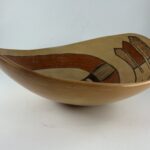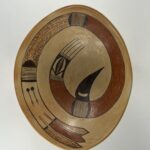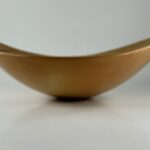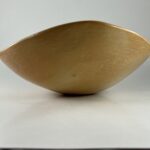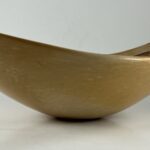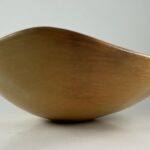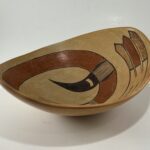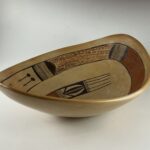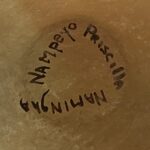- The width of the bowl is 9.375 inches.
- The lowest height is 2.6875 inches.
The large size of this bowl is unusual, as is its shape. To my eyes its curvilinear design is the most powerful ever developed by Nampeyo, Priscilla’s great grandmother. Size, shape, design and skill reinforce each other, and the result is a bowl that is both simple and spectacular.
Form:
The boat shape of bowl 2024-03 is unusual with the “prows” of the vessel 1.19-inches higher than the walls at “midship.” The walls are unusually thin and thus the pot is surprisingly light. For such a large bowl it has a very small base on which it balances perfectly in spite of its irregular form. The base is signed “Priscilla Namingha Nampeyo,” with the three words arranged in a triangle, Priscilla’s usual signature.
The exterior is substantially blushed from the outdoor dung firing while the interior is a uniform light-golden color. There are very faint striations from polishing with a smooth stone but the interior has several light scratches that occurred after the firing. The pot came with a photograph of Priscilla standing on the porch of her home holding the pot and from her appearance I would guess she made the bowl in the 1970’s or 1980’s.
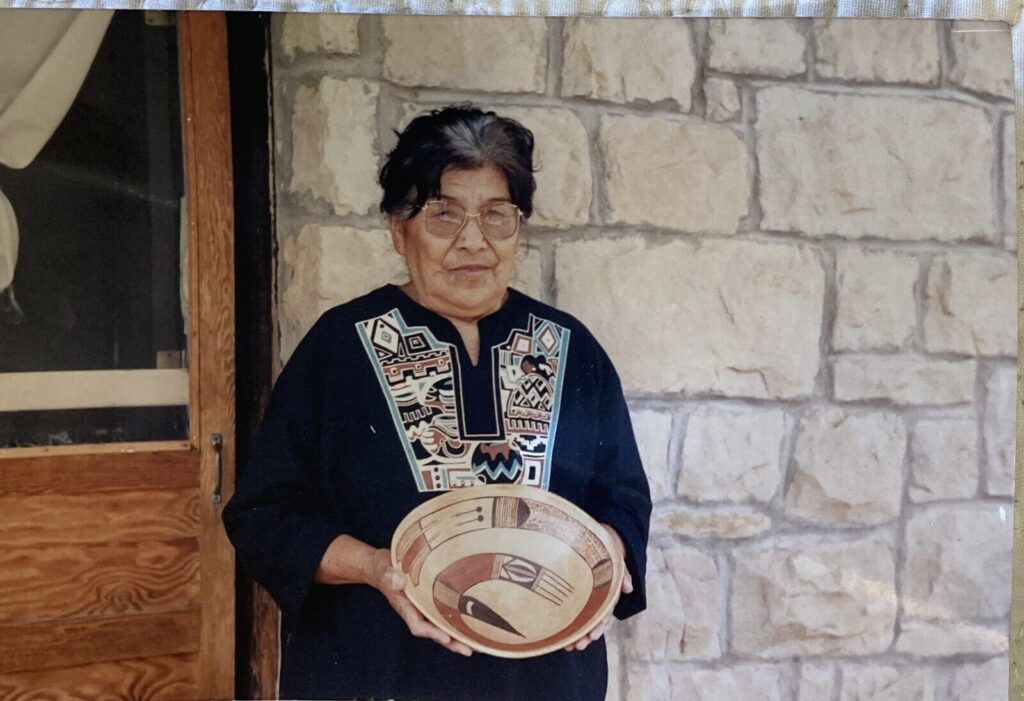
Design:
The abstract avian motif that fills the interior of the bowl is 12-inches long and 9.75-inches wide. Uncurled it would be 33.25-inches long. The width of this ribbon of design varies from 1.25-inches to 1.75-inches. A thin black line outlines the design. Drawing the outline required Priscilla to lift her yucca brush several times and turn the pot.
One end of the design is a very abstracted head consisting of 5 thin parallel black lines of somewhat unequal length separated by somewhat unequal spaces. These lines grow out of a base of 3 parallel black lines that collectively form a “two-lane highway.”
Behind this highway is a section with a complex interior design. One way to understand this section is to see it as basically black but with a large unpainted bullet-shaped form intruding into this space and facing forward. At the base of the bullet shape is a black “V” with its point facing to the rear and thus issolating two right-triangular spaces below it. Between the interior point of the “V” and the curved head of the “bullet” is drawn another two-lane highway. Based on both sides of this highway are long, flat black hills that run the length of the section. If these “hills” and the highway between them are seen as one motif, the design looks a bit like a lens-shaped seed.
Behind this complex section is a set of 5 parallel lines forming a four-lane highway. Following is a 3-inch-long solid red section ending with another black hill running the width of the design. Following is a set of 15 parallel lines ending with another wide black hill. To coin another analogy, the two black hills with the 15 parallel lines between them look a bit like a thick hamburger between two black buns. Off the curved inside border of this section is a large black “tooth” that points towards the rear of the design. Internal to and near the base of this tooth is a small, unpainted and curved rectangle.
A long, solid-red section follows, ending with another gigantic hamburger of 15 parallel lines set between two solid black hills. Another long section follows that is simply stippled with brown paint and ending with an unusually tall black hill, its rounded summit intruding into the stippling and its flat base against a set of 11 parallel lines. The last of these lines is a thick black stripe. This stripe forms the base of a long, unpainted comb with three protrusions. Set in the unpainted space are two black balls with 1.5-inch lines pointing towards the rear. The tips of these lines have three short cross bars. Each of the three protrusions ends with a black stripe that serves as the base for a pointed feather. The outside two feathers are stippled brown; the center feather is painted red.
Design Analysis:
I have occasionally seen oval-shaped pots from Hopi, but this is the first time I have seen an ellipsoid bowl with raised ends. Its large size and odd shape are eye-catching. A typical bowl has even sides which need to be peered over to see the interior design. By raising the end sections of the walls of this jar, lowering the middle sections, and filling the interior with design, Priscilla enables us to glance over the walls and see the design with an easy look. The design projects from the interior. The avian design curls around itself one-and-a-half times within an oval-like form, which reinforces the sense that we are looking at a baby chick in an egg.
The design on bowl 2024-03 was used by Nampeyo (2020-17, 2021-09) and infrequently has been used by her descendants (2011-08). To my eye this is the most dramatic design developed by Nampeyo.
Typically a pot as large as 2024-03 would carry many designs in a symmetrical layout with no one motif dominant. For this pot Priscilla chose a different tactic. She took this large pot with its eye-catching shape and filled it to the brim with a singular exceptionally-dramatic design. To an unusual degree form and design reinforce each other and together they make this pot extraordinary.
Four generations descended from Nampeyo, Priscilla Namingha Nampeyo (1924–2008) was a master ceramist who passed her skill on to four daughters and at least one son. She was capable of very-fine line-work (cf 1991-05 and 2003-03). The line-work on this bowl is not as exact. It is clear where Priscilla changed the orientation of her yucca brush to create the outline of the design. The 5 parallel lines that form the head are not equidistant nor of the same length. The wide sets of parallel lines are not of even thickness nor are they exactly parallel. Such comments are a quibble, however, since the large scale of the painting subsumes these irregularities.
A reader who wanders around this collection will discover pots that have dense, complicated iconography that require a long equally-dense discussion (cf 2021-21 or 2024-02). In contrast, bowl 2024-03 presents itself directly, without the need for a sophisticated explanation of form or design. It’s simply big, dramatic and wonderful. That’s a very satisfying pot.


